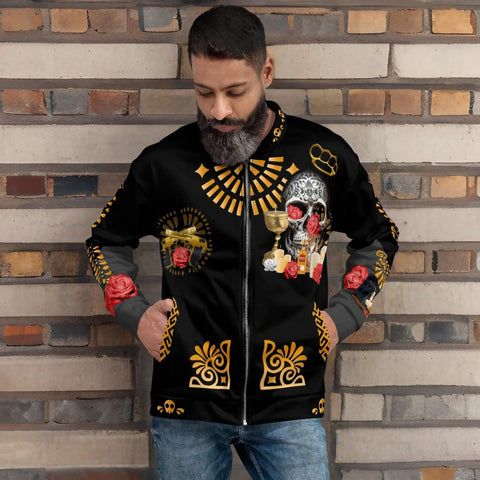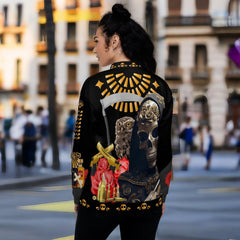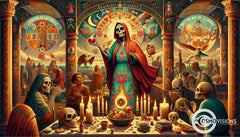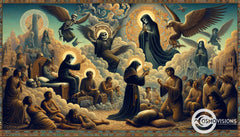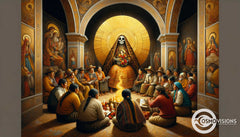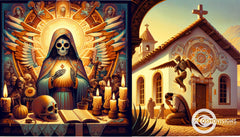Understanding La Santa Muerte: Exploring the Folk Catholicism and Modern Worship of the Mexican Folk Saint of Death
Posted by Luciano Martucci
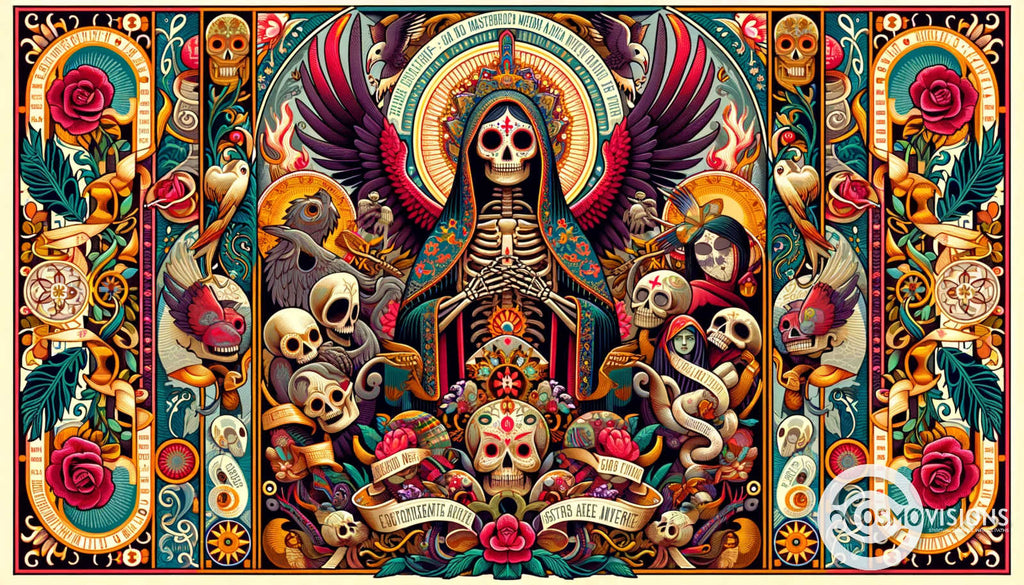
In the heart of Mexican culture, there's a mysterious figure draped in robes, wielding a scythe and promising protection: La Santa Muerte. Often seen on vibrant altars and tattoos alike, this 'Saint of Death' sparks curiosity and devotion across Mexico and beyond.
If you've ever wandered through a Mexican mercado or browsed cultural symbols online, you might have caught sight of her enigmatic skeleton smiling back at you.
La Santa Muerte is not your typical saint. While she may remind some folks of the Grim Reaper, many believe she's more than just a symbol of doom; to them, she's a powerful protector who watches over life’s uncertain paths.
Our journey will unwrap the layers surrounding this folk saint—taking us from ancient traditions to modern-day worship—and show how she brings hope to those who feel overlooked by traditional faiths.
Stay with us as we explore an enchanting world where death meets devotion. Ready to dive into the mystery? Let’s go!
Who is La Santa Muerte?
La Santa Muerte, known as the Holy Death or Saint Death, holds an iconic place in Mexican spirituality. Cloaked and skeletal, she resonates with millions who find solace and protection in her embrace.
Devotion to her transcends the simple idea of worship; it's a profound relationship that people from all walks of life cultivate with respect and hope. She offers comfort not only for those anticipating the afterlife but also serves as a guardian figure in everyday struggles.
As La Flaquita (The Skinny Lady), she wields symbols like scales for justice, a scythe for cutting negative forces, and a globe representing dominion over worldly affairs. Her followers include Catholics who feel overlooked by mainstream religion yet cling to their faith through this figure they consider holy despite absence of Vatican endorsement.
Next, let's delve into the historical roots that anchor La Santa Muerte’s presence in cultural consciousness.

Historical Background of Santa Muerte
La Santa Muerte has a rich historical background that dates back to ancient times and has strong Mexican origins. Understanding the history of this folk saint is crucial in exploring its significance in modern worship practices.
Ancient History
Ancient traditions run deep in the worship of Santa Muerte, with roots entangling through Mexico's rich soil all the way back to indigenous religious practices. Long before Spanish colonizers set foot on these lands, native people held complex beliefs about death and personified it in ways that would resonate for centuries to come.
Elders passed down ceremonies and tales where death took center stage as a powerful force rather than a distant concept.
This veneration wove its way into Mexican culture, transforming over time yet never truly losing its original essence. It found new expressions under pressure from incoming Catholic doctrines but managed to survive by adapting and blending with Christian symbols.
What emerged was a unique folk tradition honoring La Parca - not just as an abstract notion, but as a deity with influence over mortal lives, embracing those who stood at society's edges.
The skeletal figure revered today echoes this age-old spirituality that defied suppression and blossomed against odds in both public rituals and private devotions.
Mexican Origins
Santa Muerte's roots intertwine deeply with Mexican history, where indigenous practices met Spanish Catholicism. When the Spaniards came to conquer, they brought their religious icons, including depictions of death as a skeletal figure.
Over time, this figure merged with indigenous beliefs in gods governing the afterlife. The result was La Santa Muerte — a potent symbol that personifies death and offers protection and guidance to her followers.
In Mexico City's barrios and far beyond, La Niña Blanca began to hold immense significance for many seeking solace outside traditional church structures. Her visibility grew within Colonia Morelos during the mid-20th century thanks to devotees like Enriqueta Romero.
She transformed her personal shrine into a public altar, sparking widespread veneration throughout Mexico and among immigrants in other countries. People from all walks of life find refuge under Santa Muerte’s wings—LGBTQ communities, marginalized groups, even those entangled with law enforcement or drug cartels seek her blessings for various aspects of their lives.

Symbolism of Santa Muerte
The symbolism of Santa Muerte includes the colors of her gown, the objects she holds, and the guardians at her feet. Understanding these symbols is crucial to understanding the worship and significance of this Mexican folk saint in modern folk Catholicism.
Colors of Her Gown
The colors of La Santa Muerte's gown play a significant role in the worship of this Mexican folk saint of death. Each color holds specific symbolism and meaning for her devotees, representing different aspects of life and death. Here are the meanings associated with the various colors of her gown:
- Gold: Represents abundance and prosperity, often sought after by those looking for financial stability and success.
- Red: Symbolizes love, passion, and family bonds, attracting devotees seeking fulfillment in relationships and matters of the heart.
- Purple: Signifies change and transition, drawing those who seek transformation and new beginnings in their lives.
- White: Represents purity, cleansing, and protection, serving as a symbol of spiritual purity and guidance for believers.
Objects She Holds
Santa Muerte is often depicted holding several objects that carry specific symbolism related to death. These objects reflect her role as death personified and emphasize her association with justice and the afterlife.
- The scythe: This object represents death itself, signifying the end of life and the inevitability of mortality. It symbolizes the cutting of the thread of life and serves as a reminder of the impermanence of existence.
- The scale: Santa Muerte is frequently shown holding a scale, which symbolizes justice and impartiality. It signifies her role in overseeing the balance between life and death, ensuring fairness in the transition from one state to another.
- The globe: Another item often depicted in her hands is a globe, representing her dominion over all aspects of life and death across the world. It reflects her omnipresence and influence over mortal affairs.
Guardians at Her Feet
La Santa Muerte is often depicted with guardians at her feet, symbolizing her role as a protector and guide for the marginalized.
- The guardians typically represent animals such as owls, which in Mexican folklore are associated with wisdom and protection.
- The presence of these guardians reinforces the idea that La Santa Muerte offers solace and sanctuary to those who feel excluded from mainstream society.
- The imagery of the guardians at her feet highlights Santa Muerte's compassionate nature and her significance as a source of comfort for those facing social exclusion or hardship.
- This depiction also underscores the belief that she stands as an ally to those on the margins, offering them guidance and support.
- The inclusion of animal guardians serves as a powerful visual representation of the protective role that La Santa Muerte plays in the lives of her followers.

Santa Muerte in Modern Mexican Folk Catholicism
Explore the role of Santa Muerte in modern Mexican Folk Catholicism and how she is worshipped, prayed to, and honored during Day of the Dead celebrations. To learn more about La Santa Muerte, keep reading our blog!
Worship and Prayer
Santamuertistas engage in rituals and prayers that resemble traditional Catholic practices. Here are the aspects of worship and prayer related to La Santa Muerte:
- Devotees offer prayers and light candles to seek protection, healing, or guidance from La Santa Muerte.
- They also conduct novenas, nine days of devoted prayer to honor the folk saint and request specific favors or mercies.
- Some followers create altars adorned with flowers, rosaries, and offerings symbolizing their petitions to La Santa Muerte.
- Worshippers may recite psalms or adorations while holding a rosary as part of their devotional practices.
Role in Day of the Dead
Santa Muerte plays a vital role in the Day of the Dead celebrations, representing a significant aspect of Mexican folk Catholicism. During this time, devotees honor their deceased loved ones and seek Santa Muerte's protection and guidance as they navigate through the realm of death.
Many adherents believe that she can intercede on behalf of departed souls during this sacred period.
Indigenous art lovers who participate in these rituals might find significance in how the veneration of Santa Muerte connects with ancient Mesoamerican beliefs about death and the afterlife.
Santa Muerte for the Marginalized
As Santa Muerte is a key figure in the celebration of the Day of the Dead, she also plays a significant role as the patron saint for marginalized communities in Mexico. The followers of Santa Muerte primarily consist of individuals from disadvantaged backgrounds, including those who are poor and members of the LGBT community, seeking guidance and support during times of hardship.
Embracing her as "the saint of desperation and last resort," these worshipers turn to her to find solace and protection when they feel excluded or vulnerable.
Those who look up to Santa Muerte often belong to liminal spaces in society and find comfort in her presence. With millions turning to her during times of need, she offers a sense of belonging and hope for those facing various forms of marginalization.
Santa Muerte Prayers for Love and Dreams
- Devotees of Santa Muerte often turn to the folk saint for guidance and assistance in matters of love, seeking her blessings for romantic relationships and emotional fulfillment.
- The prayers to Santa Muerte for love are believed to evoke her power to attract and strengthen love bonds, as well as to bring about reconciliation in troubled relationships.
- Followers also seek Santa Muerte's intervention in their dreams, praying for clarity, insight, and guidance through their subconscious visions.
- Through these prayers, devotees express their faith in Santa Muerte's ability to help them find love and navigate the complexities of human relationships.
- The practice reflects a deep spiritual connection as individuals place their hopes and desires before the revered figure of Death, seeking solace and support in matters close to their hearts.
- For many, the act of praying to Santa Muerte for love and dreams is an integral part of their spiritual journey, offering comfort and reassurance in the face of life's uncertainties.
Controversy Surrounding Santa Muerte
Despite her popularity among marginalized communities, Santa Muerte has faced opposition from the Catholic Church and government authorities in Mexico. The controversy surrounding her worship reflects larger societal tensions around issues of religion, morality, and social exclusion.
Church Opposition
The Catholic Church has condemned the worship of Santa Muerte as satanic, vehemently opposing its veneration. This opposition mirrors the Church's campaign against evangelical and Pentecostal churches, underscoring its stance on alternative forms of spirituality.
Expressing concern that people may mistakenly perceive Santa Muerte as a Roman Catholic Church-sanctioned saint, an archbishop has urged Catholics to cease honoring her.
State Opposition
Pope Francis recently expressed his disapproval of Santa Muerte devotion during his visit to Mexico in 2016, siding with the Mexican bishops' criticism of her veneration as idolatrous and incompatible with Christianity.
State Opposition
The Mexican government and bishops in the United States have openly opposed the unofficial veneration of Santa Muerte. This opposition is largely due to the association of La Santa Muerte with illegal activities such as drug trafficking, which clashes with the values promoted by both church and state authorities.
The worship of this folk saint presents a challenge for the Roman Catholic Church, as it contradicts their official teachings and beliefs.
In addition to religious opposition, the state views Santa Muerte's cult as a threat to social order and moral values. Political leaders in Mexico and the United States are concerned that her worship may lead to an increase in illicit activities and undermine established societal norms.
Santa Muerte and the Neoliberal State
The neoliberal state in Mexico has shown opposition to the worship of Santa Muerte. Authorities have associated her veneration with criminal activities, particularly drug trafficking and violence.
Despite this, devotees continue to seek protection and solace from Santa Muerte, especially in marginalized communities facing social exclusions or economic hardships. The state's resistance has not deterred the faithful from turning to Santa Muerte for comfort, guidance, and empowerment.
Mexican folklore depicts Santa Muerte as a symbol of hope for those alienated by society. In response to the challenges posed by neoliberal policies regarding immigration and socioeconomic disparities, many individuals turn to this folk saint for support and spiritual assistance with their struggles.











